Insect & Disease Conditions Update
Emerald Ash Borer (Agrilus planipennis) – We have been conducting our mid-season lure changes and trap checks on our purple sticky traps throughout Maine over the past few weeks. Almost all of the traps have been checked, and so far, no EAB have been found.
Every week since late June, we have been releasing 3 species of parasitoids for EAB in Aroostook County. Two of the species are larval parasites, and one attacks the eggs. These parasites will not save the trees on which we are releasing them, but we hope that they will protect future generations of ash.
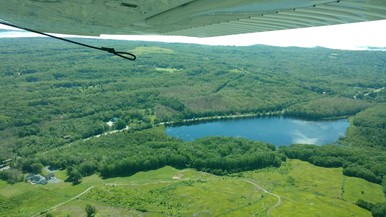
Browntail Moth (Euproctis chrysorrhoea) – The tiny first instar caterpillars have hatched from their egg masses that were laid in July. At this early stage the caterpillars begin to consume the outer layer of the leaves (skeletonization) which eventually die and turn a bronze color. Host plants includes oaks, apples, cherries, birch and various other hardwoods.
Next year plans are in the works to verify the sex ratio of adult moths that come to the lights around Maine. Preliminary and anecdotal data suggests more males than females come to the lights which is important from a mitigation standpoint.
Image: Defoliation caused by browntail in Camden, ME.
The flood of browntail moth inquiries has slowed to a trickle for now. As of Late-June, Maine CDC’s contractor, 211, fielded over 1,300 calls, 200 texts and 100 emails related to browntail moth.
Towards the end of June, we were able to make a couple of aerial survey flights to map defoliation in the Midcoast and Downeast regions and just shy of 15,000 acres have been mapped. Actual acreage of defoliation may have been significantly higher because weather and aircraft availability limited coverage of the affected area. If indicated by ground observations, we will conduct aerial surveys in late-summer to determine the extent of skeletonizing by early-instar caterpillars
|
Late-summer Caterpillar Round-up
With browntail moth weighing heavy on the minds of many folks around Maine, we receive a lot of calls this time of year involving caterpillar identification. Although most are aware that browntail moth caterpillars are hatching this time of year, many forget that they will remain small for now and only continue the remainder of their development next spring. Therefore, we usually get to give people some semi-good news for a change in that the large, late-summer caterpillars they’re concerned about are something else entirely.
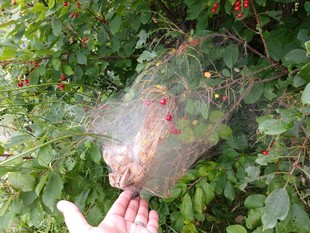
Fall Webworm (Hyphantria cunea) – With large sprawling nests made of silken webbing, fall webworm is hard to miss and can often appear to have engulfed an entire tree. Much of the confusion between fall webworm and browntail moth arises due to the small size of the nests early on and that fact that both insects can be found on some of the same tree species. As with many other aspects of forest entomology, timing and patience are key. August and September are the prime months for fall webworm caterpillar activity.
Image: An example of a fall webworm nest in mid-August.
If you observe a small nest of webbing during this time and have doubts as to which insect it belongs to, give it a week. If the size of the nest increases by magnitudes, chances are you have fall webworm. Additionally, the size of fall webworm nests should already be quite substantial by the time the small, tightly-woven winter nests of browntail moth caterpillars begin to appear later in the season.
|
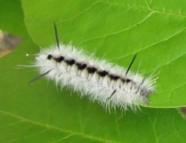
Hickory Tussock Moth (Lophocampa caryae) – Because of their bizarre appearance and local abundance in some areas, hickory tussock moth caterpillars are also hard to miss this time of year. Large by late August, these caterpillars are constantly on the move and like browntail moth caterpillars, seem to have an affinity for houses and decks. You might also notice the silken strands they use to rappel from trees to the ground, which are quite thick for caterpillar standards and almost look like dangling fishing line in the right lighting.
Image: An example of a late instar hickory tussock moth caterpillar.
While not as severe as those of the notorious browntail moth caterpillars, the dense hairs on hickory tussock moth caterpillars serve as a defensive mechanism as well. As a reminder, these can cause skin irritation to sensitive individuals and hair-bearing caterpillars should not be handled.
|
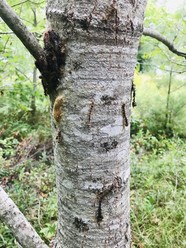
Gypsy Moth (Lymantria dispar) – Since last month’s conditions report, several additional sites in the Woolwich area were inspected for late-season evidence of gypsy moth defoliation. Though some evidence of defoliation and minor branch dieback from previous years was apparent, still the damage remains minimal. Several females were observed depositing new egg masses during surveys. There appears to be far fewer new egg masses this year as compared to last. Gypsy moth egg masses are most often adhered directly to the trunk of a tree or in sheltered area on the underside of major limbs. These protected sites are also favorable for pupation, and so large quantities of dark, exposed pupae or old pupal cases can be usually be found right alongside.
Image: An aspen tree in Woolwich with gypsy moth caterpillar cadavers, empty pupal cases, and a new egg mass.
Unlike gypsy moth, browntail moths usually deposit egg masses directly on the leaves of host trees and pupate inside silken-covered cocoons formed in a protective leaf covering. These differences in habits can be useful for easily distinguishing between the two insects.
|
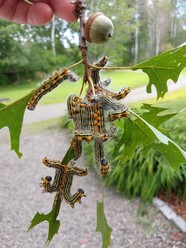
Drexel’s Datana (Datana drexelii) – Although certainly not as common as the rest, we recently received an interesting report of another hairy caterpillar known as Drexel’s Datana. This caterpillar can be identified by a yellow ring around its neck, yellow stripes on a black background running the length of the body, long white hairs, and its posture when disturbed in which it rears both head and rear into the air.
Image: Drexel's datana on red oak displaying characteristic defensive behavior.
This caterpillar might be of particular interest to some people because blueberries are one of several host plants it’s known to feed on. Though not a common pest by any means, damage done to relatively small plants like blueberry bushes can be a significant detriment to the plant. Keeping an eye out for these caterpillars and removing them if found can help avoid any serious damage.
|
|
Red-humped Caterpillar (Schizura concinna) – We’ve also received several calls this year about our native red-humped caterpillar. Sounding like something from a children’s book, this caterpillar certainly looks the part as well. Red-humped caterpillars feed gregariously on many different hardwoods, but most reports this year have involved apple trees. Similar to the behavior of Drexel’s Datana, these caterpillars will raise their abdomens in a defensive posture when disturbed.
Image: A mass of early instar red-humped caterpillars feeding on apple.
|
|
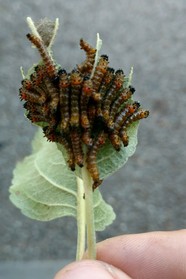 |
Winter moth (Operophtera brumata) – We have received the results from our caterpillar collection efforts this past spring to procure more Cyzenis albicans for future biocontrol releases and to determine the percentage of parasitism at our previous release sites (see table below). We are pleased to announce that the release site in South Portland has achieved a level of parasitism of 4% in only two years. This supports the theory that establishment is better when flies are released in the fall as pupae half -buried in release cages. There are a total of 544 flies to release next year and we hope to select the next release site later in September.
| Site |
Year of first release |
% Parasitism |
| Harpswell, ME |
2013 |
0.0 |
| Kittery, ME |
2014 |
16.33 |
| South Portland, ME |
2017 |
4.71 |
| Two Lights State Park |
2013 |
27.4 |
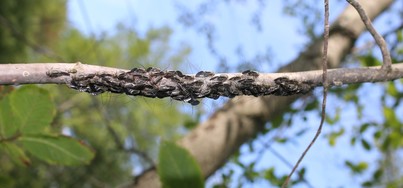
Bark lice (Cerastipsocus venosus)- By far our most conspicuous species of bark louse, these are small soft bodied insects that are often seen in groups or “herds” on the bark of various trees. Think of them as miniature buffalo roaming around the great bark prairie. Typically appearing in July, they feed gregariously on accumulations of fungi, algae, lichen, dead bark and other materials found on the bark, doing no harm to the trees they are grazing on. The young have yellow and brown striped abdomens and lack wings. As they mature they turn gray and have dark smoky-gray wings with a triangular light spot on each forewing.
Image: A herd of bark lice on a small branch in Standish.
|
Hemlock Woolly Adelgid (Adelges tsugae) – Autumn and winter are the best times to conduct any work needing to be carried out in stands of hemlock or on individual hemlock trees. If your trees are infested and you want to prune or harvest them, you can now safely work on them without risk of spreading HWA to healthy trees as the tiny mobile crawlers have now attached themselves firmly to the twigs. If your trees are not infested with hemlock woolly adelgid, this is also a good time to work on them since there is little risk of crawlers being spread via equipment.

Oak Wilt – Oak Wilt is currently not found in Maine but poses a serious threat to Maine’s oak resources and forests. Oak trees in the ‘red oak group’ (e.g. northern red oak, pin oak, black oak) are highly susceptible to the disease and can die in as little as one month after exposure. The disease attacks the tree’s vascular system leading to leaf discoloration, rapid wilting and defoliation June – July.
Image: Leaf symptoms of an oak defoliated early due to oak wilt disease in Pennsylvania.
The origin of the oak wilt fungus, Bretziella fagacearum, is unknown, but is thought to have come from Central or South America, although it is spread by a native beetles. White oak group oaks (e.g. white oak, swamp white oak, bur oak) are less susceptible carriers of the fungus that die over a much longer time.
Oak wilt can spread via sap-feeding beetles that are attracted to wounds as well as through root grafts to adjacent trees. This can lead to concentrated pockets of dead oak trees. Dead trees can form under-bark fungal structures that produce a sticky liquid and spores that attract beetles responsible for spread. Due to this, in areas where oak wilt is present, creating wounds on oak , for example by pruning, is strongly discouraged during the growing season. The fungus can also be spread by people to new areas on infested oak firewood, further stressing the importance of using local firewood.
If you have noticed oak trees dropping their leaves in June or July or groups of dead oak trees, please notify Maine Forest Service forest health staff. If the oak wilt disease is detected in Maine early, it may be eradicated. Visit www.maine.gov/forestpests/#OWD to learn more about oak wilt and what you can do to help us keep our oak trees safe.
|

Arborvitae needle blights – There are three main pathogens that cause blight symptoms in arborvitae in Maine: Phyllosticta thujae, Pestalotiopsis spp., and Kabatina juniperi. Infections by Phyllosticta and Pestalotiopsis blight fungi occur during prolonged wet conditions in spring and symptoms are typically observed throughout summer. Infections by the Kabatina blight fungus, on the other hand, are thought to occur in fall via spore dispersal and invasion of susceptible damaged foliage (caused by insect feeding or mechanical damage) with symptoms developing in spring and blighted tips often breaking off by mid-summer.
Image: Pestalotiopsis needle blight symptoms on arborvitae.
On a recent visit to an arborvitae hedge impacted by both Kabatina and Pestalotiopsis spp., it was noted that irrigation practices were likely to blame for the high degree of disease and damage. Landscape irrigation water should not be directly sprayed on trees. Further, all irrigation around trees and shrubs should be timed to coincide with the early morning hours that are already naturally high in humidity. These practices prevent unnaturally prolonging the period of leaf wetness, which will decrease the chances of pathogenic fungi successfully colonizing trees and shrubs. Protecting foliage with fungicides during the period of infection of the particular fungus/fungi affecting arborvitae is suggested, but it may take a season or two before heavily blighted areas are filled in and the aesthetics of the trees are restored. To limit Kabatina infection, avoid damage to arborvitae in late summer/fall (this is also the time for protective fungicide application for this particular disease). Finally, support tree health and vigor to provide additional protection; healthy trees are both less susceptible and more resilient to harmful insect and disease agents.
|
September 10, Bug Maine-ia 2019: 9am–3pm, free admission at the Maine State Museum, 230 State St. Augusta, ME 04333 207-287-2301.
September 19, Maine Society of American Foresters Tour: Managing Your Woodlot for Ash with the Emerald Ash Borer on Our Doorstep, 9:00 am–2:00 pm. Vassalboro, ME. Online and mail-in registration available http://www.mesaf.org/new_page_1.htm. Tour is limited to 35 participants.
September 20, Maine Woodland Owners at the Common Ground Fair, Managing Your Woodlot in the Face of an Emerald Ash Borer Outbreak, 11:00am, in the Low Impact Forestry Tent near the Pine Gate. Maine Forest Service Entomologist, Colleen Teerling and District Forested, Dan Jacobs.
For More Information Call (207) 287-2431
Office hours are 7:30 am to 4:00 pm, Monday through Friday, except for holidays. If you plan to visit either office, you may wish to call ahead just to make sure someone will be present to meet with you. (207) 287-2431
NOTE: The Augusta office has moved to the Deering Building, 90 Blossom Lane. 50 Hospital Street is no longer open to the public. The mailing address and phone numbers are unchanged. A map is available on our website, https://www.maine.gov/dacf/mfs/forest_health/contact_us.html.
Conditions Report No. 4, 2019
On-line: https://www.maine.gov/dacf/mfs/publications/condition_reports.html
Department of Agriculture Conservation & Forestry
Maine Forest Service – Forest Health and Monitoring
Contributors: Aaron Bergdahl, Mike Parisio, Thomas Schmeelk, and Colleen Teerling
Unless otherwise noted, photos by Maine Forest Service, DACF
|